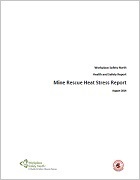Workplace Safety North / Ontario Mine Rescue
Research
Research is a vital component of continuous improvement in mine rescue. The Mine Rescue Technical Advisory Committee identifies areas of research that will provide the greatest benefit to mine rescue teams and emergency preparedness at mines. Academic institutions are principle research investigators, while Workplace Safety North (WSN) ensures the relevance of projects by involving mine operators and ensures the transfer of knowledge back to the workplace. The goal of the research is to better understand team behaviour and processes that lead to higher team effectiveness.
Team Dynamics in Non-routine Situations
WSN and Ontario Mine Rescue teams are working with Dr. Mary Waller, associate director of the Global Mining Management Program at the Schulich School of Business at York University, in furthering her research in crisis team dynamics. Previous research by Dr. Waller, a professor of organization studies, indicates that specific patterns of communication among team members during complex, time-pressured situations are associated with team performance. This work has generally not investigated interaction patterns over extended, variable workload scenarios that present multiple non-routine events to teams, nor has it investigated the role of interaction patterns within team multi-tasking. York researchers are addressing these gaps by recording and analyzing the communications patterns of mine rescue teams in regional and provincial competitions. The complex routines - problem-solving, multitasking and taking action - mine rescue teams go through under time constraints in a simulated harsh environment will provide in-depth insight into team communications.
Heat Stress Research
WSN is engaged in heat stress research with the Faculty of Health Services from the University of Ottawa. Increasing levels of heat and humidity due to extreme mining depths are significant factors affecting our mine rescue teams. WSN is looking into the fitness levels of volunteers and exploring nutrition and hydration strategies to minimize the ill-effects on volunteers exposed to elevated temperatures while performing rescue work. The initial phase of this research has focused on studying typical mining tasks and classifying them into typical activity groups. Laboratory testing has been conducted to quantify energy expenditure of specific tasks and subtasks. Focusing on an extreme task such as mine rescue is being explored as a future target. One desired outcome is to encourage the commercial development of an instrument that will alert individuals, based on their personal characteristics with a given environmental situation, when they become at risk to heat stress.
Source: http://www.workplacesafetynorth.ca/subsite/mine-rescue/research

|
Join WSN. Make a difference.
At Workplace Safety North, we are dedicated to bringing every worker home safe and healthy.